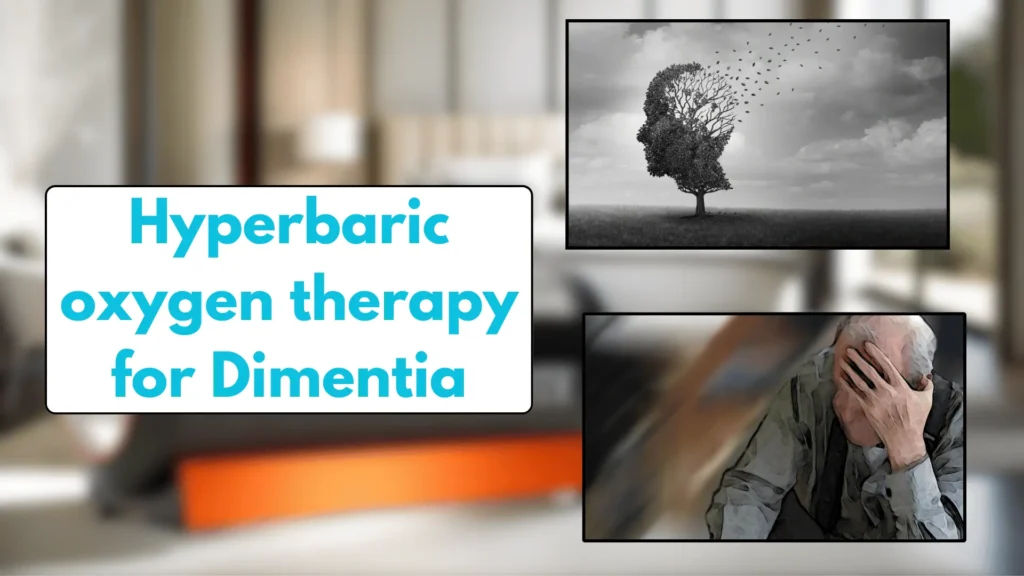Dementia affects millions of people worldwide, causing memory loss, confusion, and difficulty with daily tasks. It is not a single disease but a term for conditions that cause cognitive decline, such as Alzheimer’s disease. As dementia progresses, brain function worsens, making life challenging for both patients and caregivers. While there is no cure, treatments aim to slow the decline and improve quality of life. Hyperbaric Oxygen Therapy (HBOT) is now being explored as a potential way to support brain health in people with dementia.
HBOT involves breathing pure oxygen in a pressurized chamber. This increases oxygen levels in the bloodstream, promoting brain function, reducing inflammation, and supporting cellular repair. This article explores how HBOT may help individuals with dementia, the science behind it, and what research says about its effectiveness.
What Causes Dementia?
Dementia results from damage to brain cells, leading to problems with memory, thinking, and communication. Common causes include:
- Alzheimer’s disease – The most common cause, linked to plaque buildup in the brain.
- Vascular dementia – Caused by reduced blood flow to the brain.
- Lewy body dementia – Associated with protein deposits that affect brain function.
- Frontotemporal dementia – Results from nerve cell damage in specific brain areas.
Regardless of the type, reduced oxygen supply to the brain plays a role in cognitive decline. HBOT may help by increasing oxygen levels and supporting brain cell function.
How HBOT Works
HBOT delivers 100% oxygen at higher-than-normal pressure inside a specialized chamber. This process helps the body absorb more oxygen, which can:
- Improve brain function by enhancing oxygen supply
- Reduce inflammation linked to dementia
- Support the growth of new blood vessels
- Help repair damaged brain cells
- Boost energy production in brain cells
Since dementia is associated with poor blood circulation and inflammation, HBOT may offer benefits by addressing these underlying issues.
How HBOT May Help People with Dementia
1. Increases Oxygen Flow to the Brain
Dementia is linked to reduced oxygen supply to brain cells. HBOT helps deliver more oxygen, supporting better brain function and slowing cognitive decline.
2. Reduces Brain Inflammation
Inflammation contributes to many neurodegenerative diseases, including Alzheimer’s. HBOT has been shown to reduce inflammation in brain tissue, which may slow damage and improve cognitive function.
3. Supports Brain Cell Repair and Growth
HBOT helps the body repair damaged brain cells by increasing oxygen and promoting the production of new cells. This could help individuals with dementia maintain cognitive abilities for longer.
4. Enhances Blood Circulation
Many forms of dementia are linked to poor blood flow in the brain. HBOT stimulates new blood vessel growth, improving circulation and delivering essential nutrients to brain cells.
5. Improves Energy Production in Brain Cells
Brain cells require energy to function properly. HBOT increases ATP (energy) production, which may help people with dementia think more clearly and stay mentally active.
Scientific Research on HBOT for Dementia
HBOT and Cognitive Function
A study published in Aging found that HBOT improved memory and cognitive function in older adults. Participants showed better brain activity and reduced signs of brain aging after treatment.
HBOT for Alzheimer’s Disease
Research in Neurobiology of Aging examined the effects of HBOT on people with mild cognitive impairment, a condition that often leads to Alzheimer’s. Patients who received HBOT showed significant improvements in memory, focus, and overall cognitive function.
HBOT and Blood Flow to the Brain
A study in The Journal of Alzheimer’s Disease found that HBOT increased blood flow to the brain and improved mental clarity in individuals with early-stage dementia.
While research is still ongoing, these findings suggest HBOT may offer a non-invasive way to support brain health in dementia patients.
What to Expect from HBOT Treatment
A standard HBOT session lasts 60 to 90 minutes. Patients enter a pressurized chamber and breathe pure oxygen. The increased oxygen absorption helps brain function and overall healing.
Most treatment plans involve multiple sessions over several weeks. Some individuals notice improvements in memory, alertness, and mood after a few sessions, while others may require longer treatment to see results.
Who Can Benefit from HBOT for Dementia?
HBOT may help individuals who:
- Have early-stage dementia
- Experience memory loss or confusion
- Have vascular dementia caused by poor circulation
- Want to support brain function alongside other treatments
While HBOT is not a cure for dementia, it may help slow progression and improve cognitive abilities.
Is HBOT Safe?
HBOT is generally considered safe when administered by professionals. However, some mild side effects may occur, including:
- Ear pressure changes, similar to airplane travel
- Temporary fatigue
- Mild dizziness
People with certain medical conditions, such as lung disease or untreated ear infections, should consult a doctor before starting HBOT.
How to Access HBOT for Dementia
HBOT is available at specialized medical centers and wellness clinics. Since it is still being researched as a dementia treatment, insurance coverage may vary. Consult a healthcare provider to determine if HBOT is a good option for managing dementia symptoms.
Final Thoughts
Dementia affects memory, thinking, and quality of life. HBOT offers a potential new approach by increasing oxygen supply, reducing inflammation, and supporting brain cell repair.
While research is still ongoing, many people report positive changes in memory, focus, and cognitive function after HBOT. If you or a loved one is facing dementia, consider speaking with a healthcare professional about HBOT as a complementary treatment.

